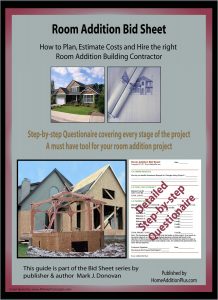How to Set Steel Beams and Lally Columns in a Basement Remodeling Project
By Mark J. Donovan
|
|
After pouring the foundation walls and installing the sill plates, next comes setting the basement steel. More specifically, this means installing steel beams and supporting lally columns in the basement.
The steel beam(s) usually run the length of the home, center span, with the lally columns placed at set distances underneath it. The lally columns rest on concrete foundation pads to help distribute the weight of the steel beam(s) and house. |
The steel beam(s) support the floor joists and much of the weight of the home. See this video to learn more about lally columns.
In particular, the steel beam(s) carry much of the weight associated with the bearing walls above it. The bearing walls include carrying the weight of second floors, subsequent upper level bearing walls, ceilings and even the roof.
By installing the sill plates first you’ll have a nailing surface to temporarily support 2×4 bracing to hold the steel beams and lally columns in place. Once you’ve set the basement steel in place and installed the floor joists you can then remove the temporary bracing that is supporting the steel.
See this short video on sill plates.
| Keep in mind that steel beams and lally columns are extremely heavy and require the use of heavy construction equipment in most cases. Consequently this work is normally left to the professionals who have the right equipment and people to install it properly and safely.
When setting steel beams they should be placed into pockets that are integrated into the foundations walls. If the steel beam extends the entire length of the basement, both sides of the beam should sit in pockets. |
 |
Lally columns (3-1/2″ steel tubes filled with concrete) are then installed at pre-determined intervals underneath the span of the steel beam. The top of each lally column should have a flange welded to the top of it with holes in it such that they match the holes in the bottom flange of the beam. This way each lally column can be bolted into place under the steel beam after the beam is lowered into its final resting position in the pockets.
In some cases only one end of the steel beam is placed into a pocket and the other end is supported by a lally column. Again, additional lally columns are installed at pre-determined intervals underneath the beam.
| If you’re not using a crane to position the steel beam(s) into place you’ll need several men to help lift and position the beam into place and to slide and bolt the lally columns into position. Also, it is important to make sure the beam is straight and level when installing it. A laser level works best for ensuring the beam is straight and level.
To make sure the beam is straight and level, drive a nail into the sill plate right next to the steel beam pocket. Repeat the process on the opposite pocket end. Make sure you position the second nail at the same relative position as the first nail at the opposite pocket. |

Use this room addition checklist and save time and money on your home addition project. |
You can do this by measuring from a common reference point at either the front or back sill plate. Now shoot your laser from one nail to the other, effectively making an optical chalk line.
You can then adjust/shim your beam as necessary to make sure it is both straight and level. In some cases you may need to slide shims in one of the pockets under the beam. If done right the top of the beam should be level with the sill plates along the entire span of the beam.
Finally, make sure the lally columns are plumb. Use a 4 foot level to check if the columns are plumb. If they are not, tap the base of them with a sledge hammer as needed to make them plumb. While tapping the lally columns make sure any steel shims under the lally columns remain in place. Once they are straight you can move on to pouring the concrete floor, which will lock in the lally columns. Again, after the floor joists are installed you can remove any 2×4 braces holding the steel beam in position.
For more help on building a home addition, see HomeAdditionPlus.com’s Home Addition Bid Sheets. Our Home Addition Bid Sheets provide you with the knowledge and information on how to plan a home building project, and what to look for when hiring contractors. They also include detailed cost breakdown tables and spreadsheets for estimating your own new home construction building costs.
Related Information Home Construction and Basement Remodeling
- House Framing and Construction Advice
- How to Install Windows in New Home Construction
- Simple Tips on Laying out and Framing Walls
Additional Framing Resources from Amazon.com
 |
 |
Free Home Addition Price Quotes with No Obligation!
Fill out our 3-5 minute quick and easy form, and receive a free price quote on a house addition from one of our prescreened and licensed home addition contractors. This process is free and there is no obligation to continue once you receive your home addition price estimate.

